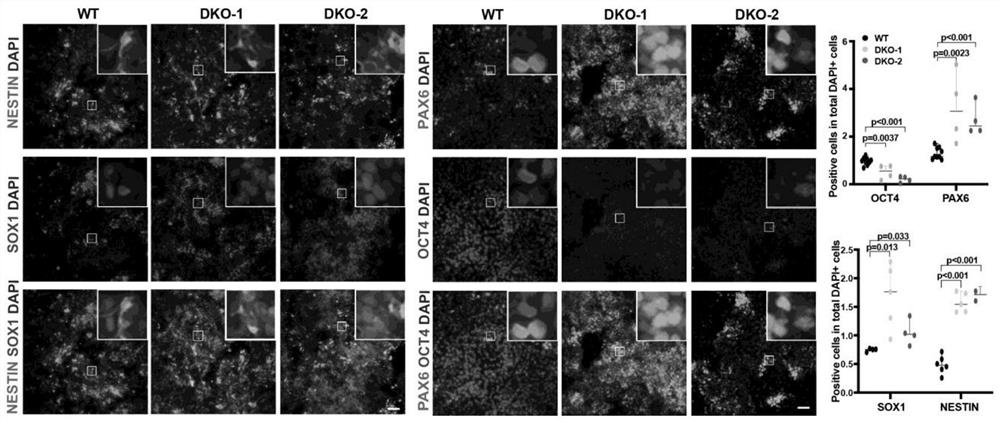Application of KDM6 as target in preparation of medicine for improving early-stage neuroectoderm differentiation efficiency
A neuroectodermal and drug technology, applied in the field of biomedicine, can solve the problems of neuronal apoptosis and decay that cannot be rooted out, and achieve the effect of improving neuronal apoptosis and neuronal metabolism
- Summary
- Abstract
- Description
- Claims
- Application Information
AI Technical Summary
Problems solved by technology
Method used
Image
Examples
Embodiment 1
[0039] Example 1, knocking out KDM6A / KDM6B in human embryonic stem cells (HUES8)
[0040] 1. Obtain KDM6A / KDM6B knockout human embryonic stem cells
[0041] The cell lines DKO1 and DKO2 in which both KDM6A / B genes are knocked out are obtained by Crispr / Cas9 technology, and the method steps are as follows:
[0042] (1) Design and synthesis of sgRNA and genotype primers
[0043] sgRNA design: Analyze the target gene sequence, screen for suitable target sites, and design one sgRNA for each target site. In general, targeting Cas9 to exons encoding functional protein domains by sgRNAs is more likely to abrogate gene function than purely targeting the 5′ exon.
[0044] In the KDM6A knockout, the nucleotide sequence of the sgRNA targeting the target gene includes:
[0045] sgRNA1-KDM6A: 5'-CCTGGGAGATAAAGCCACCA-3' (as shown in SED ID NO.1);
[0046] sgRNA2-KDM6A: 5'-ATCCTAATTCTGGCCAGTCC-3' (as shown in SED ID NO.2);
[0047] In the KDM6B knockout, the nucleotide sequence of the s...
Embodiment 2
[0083] Example 2, adding KDM6 inhibitor-GSKJ1 during early neural differentiation
[0084] 1. Materials
[0085] Control group: human embryonic stem cells (HUES8) differentiated to early neuroectoderm.
[0086] Positive group: human embryonic stem cells (HUES8) added GSK J1 and GSK126 during early neuroectodermal differentiation.
[0087] 2. Method
[0088] The steps of cell culture and differentiation were the same as in Example 1, wherein the control group was exactly the same, and the positive group was added with GSK J1 and GSK 126 from the 0th day to the seventh day of differentiation.
[0089] 3. Total RNA extraction and qRT-PCR detection
[0090] The specific operation steps are the same as in Example 1, and the qRT-PCR experimental results are as follows Figure 6 shown;
[0091] Depend on Figure 6 The qRT-PCR experiment results showed that the immunofluorescence results showed that the KDM6 inhibitor GSKJ1 increased the expression of SOX1, NESTIN and PAX6 in th...
Embodiment 3
[0095] Example 3, adding KDM6 inhibitor-GSKJ1 during early neural differentiation
[0096] 1. Materials
[0097] Control group: human induced pluripotent stem cells (WTC) differentiated to early neuroectoderm.
[0098] Positive group: human induced pluripotent stem cells (WTC) added GSK J1 and GSK 126 during early neuroectodermal differentiation.
[0099] 2. Method
[0100] The steps of cell culture and differentiation were the same as in Example 1, wherein the control group was exactly the same, and the positive group was added with GSK J1 and GSK 126 from the 0th day to the seventh day of differentiation.
[0101] 3. Total RNA extraction and qRT-PCR detection
[0102] The specific operation steps are the same as in Example 1, and the qRT-PCR experimental results are as follows Figure 8 shown;
[0103] Depend on Figure 8 The results of qRT-PCR experiments showed that the immunofluorescence results showed that the KDM6 inhibitor GSKJ1 increased the expression of SOX1, NE...
PUM
 Login to View More
Login to View More Abstract
Description
Claims
Application Information
 Login to View More
Login to View More - R&D
- Intellectual Property
- Life Sciences
- Materials
- Tech Scout
- Unparalleled Data Quality
- Higher Quality Content
- 60% Fewer Hallucinations
Browse by: Latest US Patents, China's latest patents, Technical Efficacy Thesaurus, Application Domain, Technology Topic, Popular Technical Reports.
© 2025 PatSnap. All rights reserved.Legal|Privacy policy|Modern Slavery Act Transparency Statement|Sitemap|About US| Contact US: help@patsnap.com



